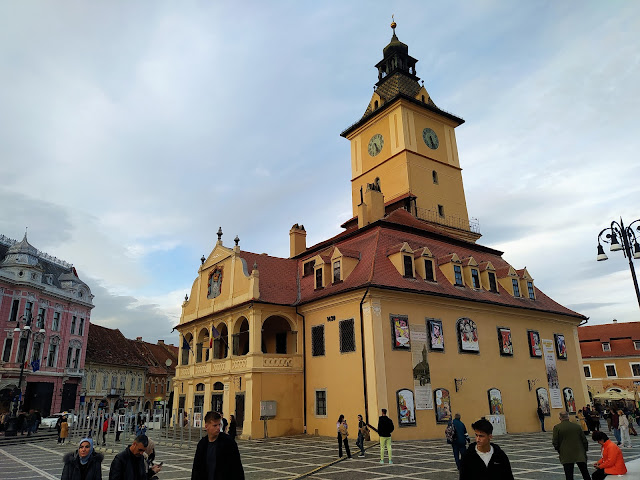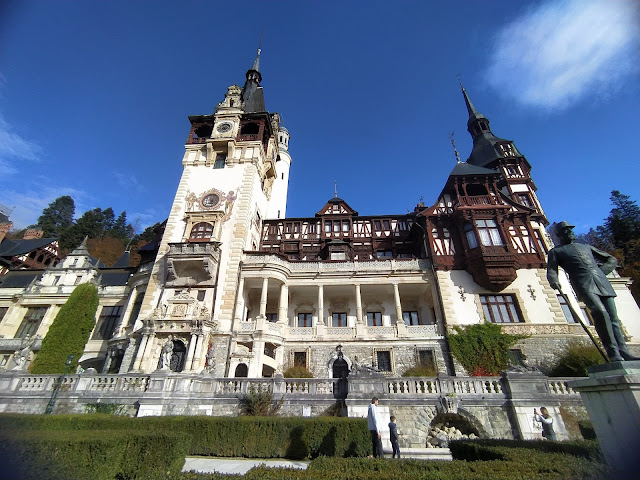Romania is an interesting country with plenty to offer visitors. It's also an uncommon destination whenever people plan their trip around Europe. I've heard good things about the country, especially Transylvania.
I spent some days exploring Brasov, Sighisoara and Sibiu during my stay in Transylvania.
Travel Guide Budget and Itinerary for Transylvania
Transylvania is a region in Central Romania. It's famous for its mountain scenery and culturally rich and historic towns and cities such as Brasov, Sighisoara, Sibiu, Cluj Napoca and others. If you think of Transylvania, your thoughts will most likely drift to Bram Stoker's Dracula. One of the regions most famous attractions is Bran Castle. Transylvania has experienced several wars and changing empires throughout its history. Fast forward to today, you'll see vestiges of its storied past in many of its towns, historic centers, museums, and architectural influences.
Getting a Visa
Depending on the type of passport you use, you can enter Romania if you have a valid Schengen visa. I'm a Filipino passport holder so I can only enter Romania if I have a valid Schengen visa.
Here's how I got a Schengen visa: how to get a Schengen visa
How to Get to Transylvania
Bucharest is your primary gateway for Romania and its different regions. The country's capital has buses and trains that connect you to different cities in Transylvania. The common route to take when exploring the region is (in no particular order) Brasov, Sibiu and Sighisoara. You could easily visit any of those places by bus or train. You could just show up at the station and buy a ticket.
You can also check out these websites for schedules:
Getting around Transylvania
Moving from one city to another is easy, you can take either the bus or train. You can show up at the station to buy tickets. You can check the schedules from the links below.
Itinerary for Transylvania
Transylvania is a huge region in Romania. For this budget and itinerary for Transylvania, you'll only cover Brasov, Sighisoara, and Sibiu with the addition of Sinaia (which is part of another region in Romania).
*This itinerary assumes you start with one full day.
Day 1
Spend the first day of your budget and itinerary for Transylvania visiting one of the most beautiful attractions in Romania, Peles Castle. Located in unassuming Sinaia, the castle is a popular attraction for both locals and foreign tourists. King Carol I of Romania saw the fetching scenery surrounding Sinaia and immediately fell in love with it. Construction took decades. The Royal Ball of Inauguration took place in 1883. The castle has more than 100 rooms and has themes inspired by different cultures around the world. The exterior of the castle is fetching with many statues, intricate details, and murals. I was only able to visit the first and second floor of the castle. You might want to check out Pelisor Castle as well during your visit. It's not too far from Peles.
Peles Castle fees:
- RON 50 - basic tour
- RON 100 - ground floor and first floor
- RON 150 - ground floor, first floor and second floor
Pelisor Castle fees:
- RON 30
Day 2
Start your first day in Brasov with a day trip to Bran Castle. The castle has become a popular tourist attraction because of its association to Dracula. King Louis I of Hungary had a castle built in the Brasov region to serve as a line of defense against the expansion of the Ottomans. Construction completed by 1388. Brasov's Transylvanian Saxons bought the castle from King Vladislas II of Hungary and Bohemia. The castle underwent multiple restorations and fortifications over the centuries. Fast forward to today, the castle is now a museum. IMO the castle was prettier on the outside than the inside. The surrounding views with the castle as the background were quite nice.
Bran Castle is often associated with Dracula and his castle. Bram Stoker described his fictional castle in a way that it would make people think it was Bran Castle. However, there is no evidence that the writer ever visited Transylvania. Vlad the Impaler, the historical person identified as the inspiration for the fictional Dracula, never ruled the castle.
Entrance fee:
- RON 55
After your day trip to Bran Castle, you'll still have some time to explore Brasov. Make your way down Strada Republicii. This is a famous pedestrian street in Brasov with many restaurants lining it. You'll eventually find your way in Piata Sfatului or Council Square. This lively area is surrounded by restaurants and shops. Many people whether they're tourists or locals end up here at some point during the day. The most notable building in the square is the Council Hall which dates to the 15th century. Not too far from the square is the Biserica Neagra or Black Church. This Gothic building dates to the 15th century when Brasov's German community had it built. You can grab a bite in one of the many restaurants near the square.
Day 3
Spend another day of your budget and itinerary for Transylvania exploring some of the attractions located in Brasov before heading over to Sighisoara. Make your way to the White Tower. It dates to the 15th century and provides visitors with a nice overlooking view of the city. Other places of interest include Weavers' Bastion, Synagogue, First Romanian School, and Rope Street (one of the narrowest in Europe) just to name a few.
Take the afternoon train or bus to Sighisoara.
Day 4
After checking out of your accommodation (and maybe after breakfast as well), head on out and explore Sighisoara. The UNESCO-listed historic center and citadel are small. It's easy to see everything in a few hours, unless you want to linger longer to soak in the laid back ambiance. The citadel's history dates to the 12th century. As Sighisoara gained prominence and wealth, the guilds had a citadel built atop a hill. This Transylvanian town is also Vlad the Impaler's birthplace.
Day 5
Sibiu is a favorite destination of mine because of its old world charm. It's home to the largest German minority in the country and has many beautiful traditional buildings. After breakfast drop by the Piata Mare or Grand Square. The latter dates to the 1360s and is a place where many locals and visitors congregate. Here you'll find notable buildings such as the Brukenthal Palace and the Jesuit Church. The Council Tower is a prominent structure that'll immediately grab your attention. It dates to the 13th century and was an important defensive structure. As you go through the passage under the Council Tower, you'll be in Piata Mica or Small Square. Here you'll find more traditional buildings that are centuries old but are now shops, cafes, or restaurants. You'll also notice the eyes-like shape of the buildings' windows. Not too far from the square is the oldest iron bridge in the country, the Bridge of Lies. Make your way to the Sibiu Lutheran Cathedral, which began construction in 1371 and finished in 1520. Huet Square nearby is home to many buildings dating from the 1400s to 1700s.
Head on over to Lower Town after exploring the Upper Town. The former was home to merchants and craftsmen while the latter was home to the clergy and rich families of Sibiu. You can see the contrast between the size of the houses and buildings in this part of town.
You might have walked along Strada Nicolae Balcescu on your way to the two historic squares of Sibiu. This area also has several historical monuments lining its streets. Other notable places in Sibiu include the Holy Trinity Cathedral, Museum of History, Stairs Passage, and the Brukenthal National Museum.
Day 6
It's possible to see Sibiu's highlights in one full day but it will depend on whether you spend time inside museums. I would reserve this day for simply hanging out in the city's historic areas. There's a number of cafes and restaurants where you can dine out. Sibiu has a nice, laid back vibe which I really liked. If you have the time or interest you can go on day trips to the ASTRA Museum of Traditional Folk Civilization and Platinis (a mountain resort).
You can catch the late afternoon train or bus to Bucharest or elsewhere in Romania.
You can read my post about Bucharest here: budget and itinerary for Bucharest
Where to Stay
I usually stay in hostel dorms because they're the most affordable option. Sibiu, Sighisoara, Brasov and Sinaia provide you with plenty of accommodation options during your stay. I use www.booking.com whenever I look for a place to stay during a trip.
Budget for Transylvania
Romanian Lei or RON is the currency of Romania. As of this writing they still use their own currency and have yet to use the euro full-time. You can use your debit or credit card to pay for stuff if you don't want to hold too many loose bills and coins.
A budget of around RON 223 or roughly US$50 a day is enough to enjoy your trip around the towns and cities in Transylvania included in this itinerary. This covers a bed in a dorm room, eating at affordable restaurants and cafes (with the occasional splurge), taking public transportation, and a few paid attractions. Cities and towns in Romania are affordable compared to other places in Europe. You can spend more or lower than the amount mentioned earlier. It all depends on your travel style. You have some luxury options if you want to splurge during your trip.

























nice!
ReplyDelete